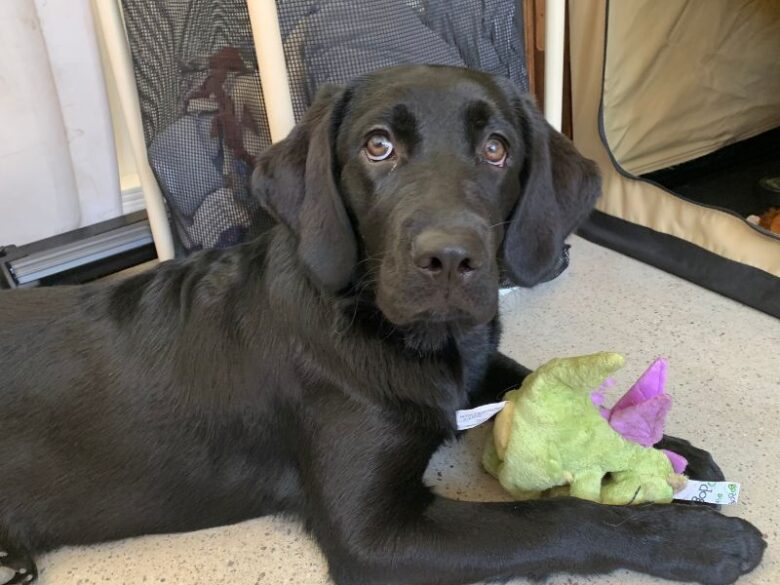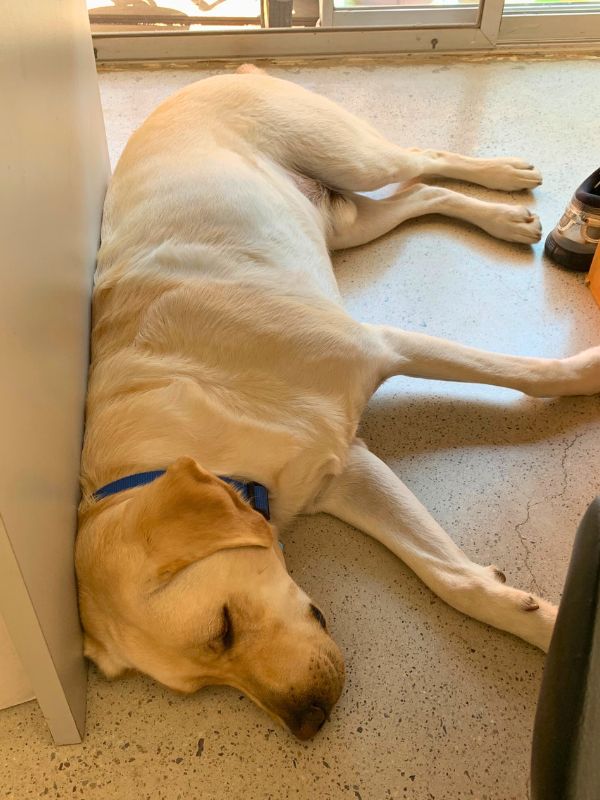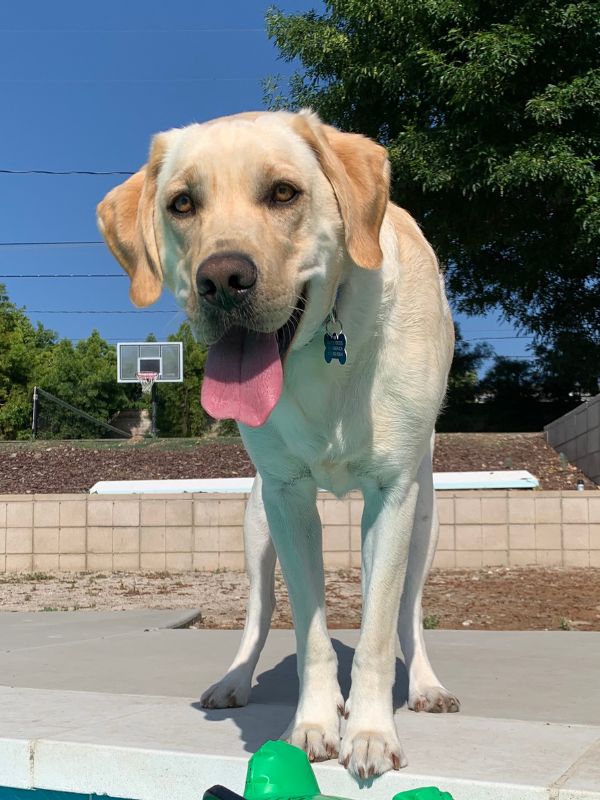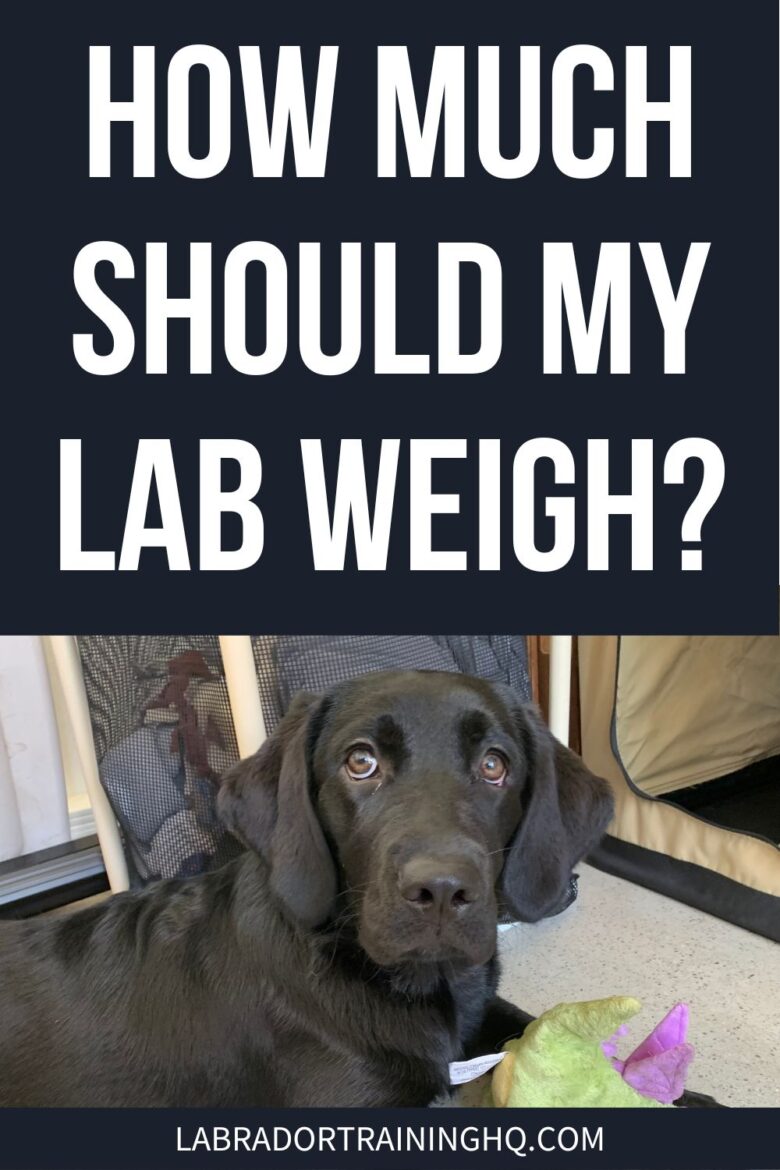How Much Should My Lab Weigh?
This post may contain affiliate links. We may earn money or products from the companies mentioned in this post.
Labrador retrievers are beloved family members. So it’s easy to want to give them treats when those puppy-dog eyes stare up at you, begging for food.
But too much of a good thing–food and treats–can lead to many potential health problems.
If your Labrador Retriever is starting to get a little pooch in his belly your might be thinking how much should my lab weigh?

It’s important for your lab to be a healthy weight. But there are many factors that enter into what determines a healthy weight for your particular lab.
Basic Factors Regarding What Your Lab Should Weigh
According to the American Kennel Club, male adult labs should weigh between 65 to 80 pounds and be between 22.5 and 24.5 inches at the shoulder.
And female labs should weigh between 55 and 70 pounds and be between 21.5 and 23.5 inches at the shoulder. But keep in mind that even healthy labs may fall outside of these guidelines.
There are many variables that enter into why a dog is a particular weight, including the following:
- Genetics. The parents and family tree of a lab determine his potential size and structure.
- Diet and nutrition. In order to reach his potential, a lab requires the proper diet for his stage of life and activity level.
- Exercise. A lab who is a couch potato will generally require fewer calories than one who is active.
- Gender. Female labs usually weigh less than male labs at the same life stage.
Contrary to popular opinion, spaying or neutering doesn’t really affect how much a lab weighs.
English vs. American Labrador Retrievers
Although there is no recognized separate breed of English and American labs, in reality there are distinctions regarding their breeding.
English labs are bred for the conformation ring and generally weigh in at the higher end of the desired range for labs.
They’re usually bulkier and larger-boned than American labs are. And they may weigh even 20 more pounds than American labs without being overweight.
American labs, aka field-bred labs, are bred from working lines, in order to hunt. They are leaner and more muscular than English labs.
Labrador Colors: Do Certain Colors of Labs Have Different Weights?
There is no definitive guide stating that labs of certain colors weigh more than others. But their breeding and function enters into whether a lab will weigh more.
- Black Labradors. Black labs are found in both English and American labs. But an English-bred lab is likely to weigh more than an American lab is.
- Chocolate Labradors. They are more likely to be from conformation lines than those from working, field lines. So chocolate labs are more likely to be at the higher end of the weight spectrum.
- Yellow Labradors. They are found in both show and field lines, so there is no likelihood that a yellow lab will weigh more. But cream and “white” labs are generally English labs. So they’re more likely to be at the heavier end of the spectrum.
- Other colors. Although not a recognized color, red fox labs are generally American, field-type labs. So they’re more likely to be leaner and lighter.
What Is an Ideal Lab Weight?
In order to determine whether you lab’s a healthy weight, you need to look at the whole picture.
Muscle weighs more than fat does by volume. So it’s conceivable that a very fit lab can weigh more than one who isn’t fit.
Body condition and general health determines what your lab should weigh.
Labrador retrievers usually reach their full height between nine and 12 months of age. But they are still growing and filling in with fat and muscle until they’re about 18 to 24 months old.
Vets use a Body Condition System (BCS) in which you visually inspect the dog and actually feel his body to determine whether he’s an appropriate weight. There are nine different levels that are measured.
You look at the dog’s ribs, waistline, and tummy. And you gently palpate the dog to feel how much fat covers those areas.
The chart cited above breaks down nine different gradations of a dog’s body condition.
In the first three levels of the chart, a dog is determined to be too thin.
Ribs, lumbar vertebrae, and pelvic bones are prominent. And there may even be muscle wasting. There is no to little discernible body fat. And there is an obvious waist and abdominal tuck.
In the ideal range, levels four to five, ribs are palpable without excess fat. The waist is easily noted when viewed from above. And there is an evident abdominal tuck when viewed from the side.
In the last four levels of body condition, steps six to nine, the dog is too heavy. At step six, the dog’s ribs are palpable with a slight excess of fat covering. And the dog has a discernible but not prominent waist when viewed from above and an apparent tummy tuck when viewed from the side.
The last three steps range from the ribs barely being palpable to massive fat deposits over the body with no abdominal tuck and even abdominal distension.
So you really need to determine where your dog is along this scale.
If in doubt, check with your vet to determine whether your lab is an appropriate weight for his age, size, and activity level.

Labrador Growth
Labs keep growing height-wise until they’re about 12 months old, when they have a lanky appearance. But they’ll be filling in until they’re about 18 to 24 months old.
So expect them to keep weighing more during that period.
Factors regarding how large a lab will get include:
- Genetics. Generally larger parents and lineage means larger lab puppies.
- Paw size. You can look at a puppy’s paws and, if they’re large, generally a puppy will be large too.
- Age. Of course, as a lab gets older, he should grow.
During the first six months, a lab has rapid rate increases, including growth spurts.
On average, a puppy will gain about two or so pounds per week. So a five-week-old puppy will be about 10 pounds and a 13-week-old puppy around 26 pounds.
LABRADOR RETRIEVER WEIGHT & GROWTH CHARTS
Male Labrador Weight & Growth Chart
| Weight Range | Height Range | |
| 8 weeks | 8–12 lbs. | 8–12” |
| 9 weeks | 10–14 lbs. | 8–12” |
| 10 weeks | 12–18 lbs. | 10–12” |
| 11 weeks | 14–19 lbs. | 10–12” |
| 3 months | 22–26 lbs. | 12–15” |
| 4 months | 25–31 lbs. | 12–15” |
| 5 months | 33–49 lbs. | 15–18” |
| 6 months | 40–50 lbs. | 15–18” |
| 7 months | 51–59 lbs. | 16–19” |
| 8 months | 55–60 lbs. | 18–20” |
| 9 months | 57–68 lbs. | 20–23” |
| 10 months | 55–58 lbs. | 22–25” |
| 11 months | 62–75 lbs. | 22–25” |
| 1 year | 64–77 lbs. | 22–25” |
| 2 years | 64–80 lbs. | 22–25” |
Female Labrador Weight & Growth Chart
| Weight Range | Height Range | |
| 8 weeks | 8–12 lbs. | 7–10” |
| 9 weeks | 10–13 lbs. | 7–10” |
| 10 weeks | 12–17 lbs. | 8–12” |
| 11 weeks | 14–19 lbs. | 8–12” |
| 3 months | 20–26 lbs. | 10–14” |
| 4 months | 25–30 lbs. | 10–14” |
| 5 months | 35–49 lbs. | 12–15” |
| 6 months | 38–50 lbs. | 12–15” |
| 7 months | 40–55 lbs. | 15–18” |
| 8 months | 45–0 lbs. | 17–20” |
| 9 months | 48–62 lbs. | 20–22” |
| 10 months | 53–65 lbs. | 21–23” |
| 11 months | 53–66 lbs. | 21–23” |
| 1 year | 55–68 lbs. | 21–23” |
| 2 years | 55–70 lbs. | 21–23” |
Reasons To Weigh Your Labrador
Of course your lab’s body appearance as described in the Body Conditioning Scale above is an important consideration regarding whether your lab’s an ideal weight.
But it’s a good idea to actually know his weight as a baseline should he lose or gain weight.
Adult Lab Weight-Loss Program
If you need your adult lab to lose weight, it’s a good idea to weigh him on a regular basis to see if he’s meeting the scheduled goals that you and your vet have set for his weight-loss program.
You’ll probably have to weigh him at your vet or a pet store with the proper scale to get a valid weight.
When we took our dogs for socialization out to a local pet store that also had a veterinary practice, we weighed each dog just to keep track of their weight.
A weight gain of even half a pound on a smaller dog can be a lot on their structure.
But remember to also visually inspect and gently palpate your dog to see if he’s the right weight for his structure.
Say your lab’s eating the proper amount and getting an appropriate amount of exercise, rapid weight-gain can be caused by hyperthyroidism and insuloma. A vet visit’s in order if this happens.
Labs Who Are Too Thin
What if your young or adult lab appears to be too thin?
There may be medical reasons, such as worms. So it’s best to have a vet check if anything is amiss.
Or it could be that your dog needs more food than he’s getting or a higher-calorie food, depending on his activity level.
So, depending on your puppy’s age, you may want to weigh your puppy daily or even every few days if he’s very thin. Ask your vet.
With a puppy, you can hold him in your arms while you get on the scale. Then weigh yourself and deduct your weight to determine your pup’s weight.
For tiny puppies, you can even use a kitchen scale and weigh just the pup.
If you have a puppy who is too thin and underweight, a health issue may be the cause.
If bred by an unscrupulous breeder, the pup may have been sold too young.
Puppies should remain with their littermates and mother until they are at least eight weeks old.
Some deceitful breeders sell the puppies when they are too young because they are perceived as being cuter by the public. And the breeder doesn’t have to care for them anymore.
If there’s any doubt that your puppy isn’t properly thriving, a vet visit is crucial, as puppies can go downhill very quickly.
Medication Doses
Your vet will probably weigh your dog to determine what dose of medication he should take, including heartworm medicines and those for flea and tick control.
Reasons Why Your Lab May Be Overweight or Obese
Unfortunately, labs tend to gain too much weight and can pretty easily become obese. This can partially be due to genetics.
In fact, by one estimate, about 60 percent of labs are overweight or obese.
After all, labs are well-known to be ravenous and act as if they haven’t been fed for weeks-even when they just ate an hour ago. They also will eat rocks, socks, and whatever else is in their path.
I know I often make excuses for my own weight gains. I was too busy to exercise or the leftover piece of cake was calling my name.
But labs actually do have a valid excuse for their seemingly unlimited appetite.
Scientists at Cambridge University found that there is a genetic mutation that causes them to be able to regulate their appetites.
A study of 310 labs were found to be missing all or part of a gene known as the POMC.
This gene regulates appetite in some species and helps them sense how much fat the body has stored. Without it, a dog doesn’t know when he’s had enough, so he just keeps eating and eating.
I note that the POMC gene is also found in humans. So can I use this as an excuse for why I overeat sometimes?
Weight gain can also be caused by giving in to the adorable puppy-eyes begging you for more treats or table scraps.
Just don’t feed him too much food for his age and activity level. And make sure that he has a sufficient amount of exercise.
Depending on his health, this can include walks, hikes, swimming, dock diving, hunting, and agility.
Health Issues Caused By Obesity
In addition to not appearing to be healthy, there are many reasons to be sure that your lab isn’t overweight. These include:
- Reduced quality of life
- Joint and bone health issues
- Spine and back issues
- Mobility issues
- Arthritis
- Hip dysplasia
- Respiratory issues making it difficult to breathe
- Heart disease
- Increased risk of cancer
- Lower life expectancy (even as much as two years)
How To Help Your Lab Lose Weight

Of course it makes sense to give fewer calories and increase your lab’s exercise, just as we would when trying to lose weight.
But also take into account your dog’s nutritional needs. When deciding that your lab needs to lose weight, take into consideration the following:
1. Vet visit
If your lab is overweight, I advise you to make a vet visit to make sure that he’s healthy and that there aren’t any medical problems.
A medical issue may need to be addressed before considering changing his diet or exercise routine.
2. Exercise
Consider your lab’s body condition when deciding what type of exercise he can endure.
Walks, retrieving, and swimming can all be great ways for a lab to exercise.
If he needs to lose a lot of weight, consult your vet or even a veterinary nutritionist to make a successful plan to help your lab shed those excess pounds.
For obese labs, you might even need specialized exercise, such as water therapy, which is easier on his joints while he sheds those excess pounds.
The correct exercises will improve your labrador’s cardiovascular health, build muscle, and build bone strength.
3. Change his diet
If you’re considering changing your lab’s diet, it’s best to consult your vet.
You may need to cut the portions that he currently receives. Or you may need to change his diet totally–even giving him a prescription food for dogs who need to lose weight.
4. Give fewer or lower calorie treats
Treats can have a lot of excess calories.
So when training your lab, you may need to cut back on the number of treats he receives. Or give lower-calorie treats.
Sometimes I even give small pieces of cooked green beans as a treat. They’re low in calories and my dogs love them and think they’re a gourmet treat.
5. Cut out any table scraps
If anyone is slipping your lab table scraps, it’s time to stop it.
Labs are experts at begging for food. After all, those puppy-dog eyes and nudging you to share your dinner are hard to resist.
But, for your dog’s health, it’s important that you don’t give in to temptation.
Reasons Why Your Lab May Be Underweight
There are many reasons why your lab may be underweight. Some require medical intervention. These include:
- Not eating enough for his activity level. If you have a very active lab who needs to gain weight, the answer may be as simple as increasing the amount that he eats. Or even transitioning him to a food that’s made for more active dogs.
- Malnourishment. This can occur because of inappropriate food for your lab’s stage of life, size, or activity level.
- Intestinal worms or parasites. If your lab has these, he may not be receiving the right amount of nutrients from his food.
- Sickness or illness. Certain maladies can cause a dog to lose muscle mass and fat.
Health Issues Caused By Being Underweight
If your lab is healthy and slightly underweight, there may not be any major health issue. But if he’s too thin, there may be certain health issues involved, including the following:
- Lethargy
- Hair loss
- Malnourishment
- Dehydration
- Adverse bodily functions
- Diminished projected lifespan
How To Help Your Lab Gain Weight
Whenever you decide to make any changes because a dog is over or underweight, consider why he isn’t the correct weight.
1. Vet visit
There may be a medical reason why your lab fails to reach his optimal weight.
2. Increase his dietary intake
If your vet advises you that nothing else is wrong, ask about how you should increase his caloric intake.
Inquire whether you should add a meal or change his diet completely. This can also include giving more treats when appropriate.
3. Decrease exercise
Although a healthy lab requires regular exercise, you can have too much of a good thing.
What NOT To Do: Don’t Try This at Home
Many people will look at a healthy lab who has a little coat of fat on his ribs and a tucked tummy and think that he’s emaciated even though he’s within the ideal portion of the body condition scale.
And, meaning well, they may attempt to get you to put weight on your lab. If in doubt, check with your vet.
My current golden is in the ideal range of the scale. Sometimes people will comment that he should be heavier.
But he’s about nine years old, healthy, active, and happy. My vet agrees that he’s a great weight and fit.
Don’t guess what your lab should weigh. The above article provides guidelines.
FAQs
How can I tell if my lab’s the right weight?
Do a visual and tactile inspection. As a general guideline, his ribs should be palpable without excess fat.
Your lab’s waist should be easily noted when viewed from above. And there should be an evident abdominal tuck when viewed from the side.
My vet said that my lab’s too fat. He currently gets two meals a day. Should I just cut out a meal?
No. You may need to lessen the amount at each meal or even switch him to a different food. And no table scraps or too many high-calorie treats.
Increasing his exercise can also help him lose weight.
It’s best to check with your vet regarding what food and how much he should eat. Also ask what type of exercise he should get.
My lab’s always hungry. He begs for food and even tries to get in the trash. What should I do?
First, manage his environment so that he can’t eat from the trash or other sources that may be harmful to him.
No one should give in to his begging. When he receives something for begging, it only reinforces the behavior.
And have a vet check to determine whether there’s a medical problem.
Final Thoughts
There are many factors that go into what the correct weight is for your lab. General guidelines provide a starting point.
Look at his general health and appearance to see if he’s where he should be for his age and build.
Was your lab overweight or underweight?
If so, what have you done to help him reach his correct weight? Was it successful?
Please tell us about it in the comments section below.
Save To Pinterest

Top Picks For Our Dogs
- BEST PUPPY TOY
We Like: Calmeroos Puppy Toy w/ Heartbeat and Heat Packs – Perfect for new puppies. Helps ease anxiety in their new home. - BEST DOG CHEW
We Like: Bones & Chews Bully Sticks – All of our puppies love to bite, nip, and chew. We love using Bully Sticks to help divert these unwanted behaviors. - BEST DOG TREATS
We Like: Crazy Dog Train Me Treats – One of our favorite treats for training our service dog puppies. - BEST FRESH DOG FOOD
We Like: The Farmer’s Dog – A couple months ago we started feeding Raven fresh dog food and she loves it! Get 50% off your first order of The Farmer’s Dog.
For a list of all the supplies we get for our new service dog puppies check out our New Puppy Checklist on the PuppyInTraining.com blog.
How Much Should My Lab Weigh? was last modified: May 6th, 2023 by
